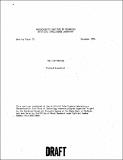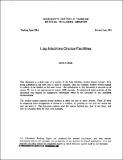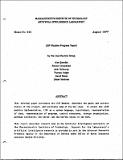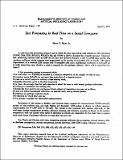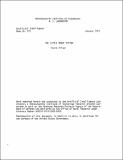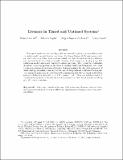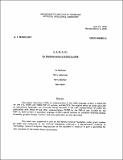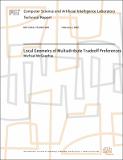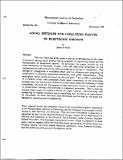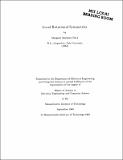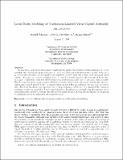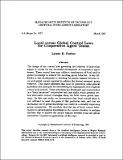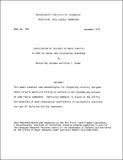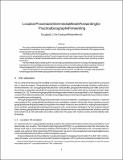Browsing Computer Science and Artificial Intelligence Lab (CSAIL) by Title
Now showing items 1881-1900 of 3804
-
The LISP Machine
(MIT Artificial Intelligence Laboratory, 1974-11) -
Lisp Machine Choice Facilities
(MIT Artificial Intelligence Laboratory, 1981-06)This document is a draft copy of a portion of the Lisp Machine window system manual. It is being published in this form now to make it available, since the complete window system manual is unlikely to be finished in the ... -
LISP Machine Progress Report
(1977-08-01)This informal paper introduces the LISP Machine, describes the goals and current status of the project, and explicates some of the key ideas. It covers the LISP machine implementation, LISP as a system language, ... -
Lisp: A Language for Stratified Design
(1987-08-01)We exhibit programs that illustrate the power of Lisp as a language for expressing the design and organization of computational systems. The examples are chosen to highlight the importance of abstraction in program ... -
List Processing in Real Time on a Serial Computer
(MIT Artificial Intelligence Laboratory, 1977-04-01)A real-time list processing system is one in which the time required by each elementary list operation (CONS, CAR, CDR, RPLACA, RPLACD, EQ, and ATOM in LISP) is bounded by a (small) constant. Classical list processing ... -
The Little Robot System
(1973-01-01)The Little Robot System provides for the I.T.S. user a medium size four degree of freedom six axis robot which is controlled by the PDP-6 computer through the programming language Lisp. The robot includes eight force ... -
Liveness in Timed and Untimed Systems
(1993-12)When proving the correctness of algorithms in distributed systems, one generally considers safety conditions and liveness conditions. The Input /Output (I/)0 automaton model and its timed version have used successfully, ... -
LLOGO: An Implementation of LOGO in LISP
(1974-06-01)This paper describes LLOGO, an implementation of the LOGO language written in MACLISP for the ITS, TEN50 and TENEX PDP-10 systems, and MULTICS. The relative merits of LOGO and LISP as educational languages are discussed. ... -
LLOGO: An Implementation of LOGO in LISP
(1975-03-01)This paper describes LLOGO, an implementation of the LOGO language written in MACLISP for the ITS, TEN50 and TENEX PDP-10 systems, and MULTICS. The relative merits of LOGO and LISP as educational languages are discussed. ... -
A Local Front End for Remote Editing
(1982-02-01)The Local Editing Protocol allows a local programmable terminal to execute the most common editing commands on behalf of an extensible text editor on a remote system, thus greatly improving speed of response without ... -
Local Geometry of Multiattribute Tradeoff Preferences
(2007-02-01)Existing preference reasoning systems have been successful insimple domains. Broader success requires more natural and moreexpressive preference representations. This thesis develops arepresentation of logical preferences ... -
Local Methods for Localizing Faults in Electronic Circuits
(1976-11-01)The work described in this paper is part of an investigation of the issues involved in making expert problem solving programs for engineering design and for maintenance of engineered systems. In particular, the paper ... -
Local Rotational Symmetries
(1985-08-01)This thesis describes a new representation for two-dimensional round regions called Local Rotational Symmetries. Local Rotational Symmetries are intended as a companion to Brady's Smoothed Local Symmetry Representation ... -
Local Rule Switching Mechanism for Viral Shell Geometry
(1995-06)In a previous paper [Berger et al., PNAS 91 7732,1994] a theory of virus shell formation was proposed in which shell assembly is directed by local interactions of the coat ans scaffolding subunits. This theory requires ... -
Local Rules Modeling of Nucleation-Limited Virus Capsid Assembly
(1998-08)We describe an application of computer modeling to the study of the kinetics of virus capsid (protein shell) assembly. We examine two proposed models of the source of nucleation-limited growth, an observed growth pattern ... -
Local Versus Global Control Laws for Cooperative Agent Teams
(1992-03-01)The design of the control laws governing the behavior of individual agents is crucial for the successful development of cooperative agent teams. These control laws may utilize a combination of local and/or global ... -
Localization and Positioning Using Combinations of Model Views
(1992-09-01)A method for localization and positioning in an indoor environment is presented. The method is based on representing the scene as a set of 2D views and predicting the appearances of novel views by linear combinations ... -
Localization of Failures in Radio Circuits: A Study in Causal and Teleological Reasoning
(1974-12-01)This paper examines some methodologies for diagnosing correctly designed radio circuits which are failing to perform in the intended way because of some faulty component. Particular emphasis is placed on the utility ... -
Location Recognition Using Stereo Vision
(1989-10-01)A mobile robot must be able to determine its own position in the world. To support truly autonomous navigation, we present a system that builds and maintains its own models of world locations and uses these models to ...

